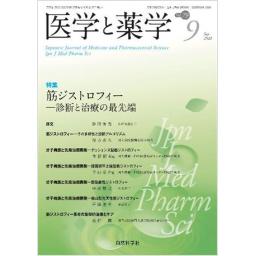1) Fardeau M : L'Homme de chair. 岩田誠 (総監訳), 武田伸一 (監訳), 石垣景子, 他 (編) : 筋学を築き上げた人々, pp.97-123, 診断と治療社, 東京, 2021.
2) Erb WH : Dystrophia muscularis progressiva. Klinische und pathologischanatomische Studien. Deut Zeits Nervenheilk 1 : 13-94・173-261, 1891.
3) 難病情報センター : 筋ジストロフィー (指定難病113). https://www.nanbyou.or.jp/entry/4523
4) Public Law 107-84. https://www.congress.gov-/107/plaws/publ84/PLAW-107publ84.pdf
5) Gowers WR : Pseudo-hypertrophic muscular paralysis : a clinical lecture. J. & A. Churchill, London, 1879.
6) 石原傳幸 : X染色体性筋ジストロフィー. 杉田秀夫, 小澤英二郎, 埜中征哉 編, 新筋肉病学, pp.502-516, 南江堂, 東京, 1995.
7) 神経・筋疾患患者登録Remudy. ジストロフィノパチー患者登録サイト. http://www.remudy.jp/dystrophinopathy/index.html
8) Walton JN, Nattrass EJ : On the classification, natural history and treatment of the myopathy. Brain 77 : 69-231, 1954.
9) Bonne G, Rivier F, Hamroun D : The 2018 version of the gene table of monogenic neuromuscular disorders (nuclear genome). Neuromuscul Disord 27 : 1152-1183, 2017.
10) Online Mendelian Inheritance in Man (OMIM). https://www.ncbi.nlm.nih.gov/omim
11) Straub V, Murphy A, Udd B, LGMD workshop study group : Limb girdle muscular dystrophies-Nomenclature and reformed classification. Neuromuscul Disord 28 : 702-710, 2018.
12) 尾方克久 : 顔面肩甲上腕型筋ジストロフィー. 下畑享良 編, 脳神経内科診断ハンドブック, pp.456-459, 中外医学社, 東京, 2022.
13) 尾方克久 : Emery-Dreifuss型筋ジストロフィー. 下畑享良 編, 脳神経内科診断ハンドブック, pp.460-462, 中外医学社, 東京, 2022.
14) 尾方克久 : 筋疾患, 神経筋接合部疾患. Medical Practice 38 : 1865-1869, 2021.
15) 久留聡, 鈴木重明, 尾方克久, 他 : 診断未確定慢性ミオパチーにおける壊死性ミオパチー関連抗体スクリーニング. 臨床神経 57 : 562-566, 2017.
16) 斎藤良彦, 西野一三 : 筋炎・壊死性ミオパチーの筋病理 : 筋炎と筋ジストロフィーは病理で鑑別できるか. Brain and Nerve 神経研究の進歩 73 : 147-159, 2021.
17) 石垣景子, 池田 (谷口) 真理子, 白石一浩 : 先天性筋ジストロフィー (乳児~小児筋ジストロフィーの病型診断を念頭に). 厚生労働科学研究費 難治性疾患政策研究事業「筋ジストロフィーの標準的医療普及のための調査研究」班 編, 筋ジストロフィーの病型診断を進めるための手引き, pp.4-16, 2019. https://doctors.mdcst.jp/diagnosis/manual/
18) 尾方克久 : 肢帯型筋ジストロフィー (小児~成人筋ジストロフィーの病型診断を念頭に). 厚生労働科学研究費 難治性疾患政策研究事業「筋ジストロフィーの標準的医療普及のための調査研究」班 編, 筋ジストロフィーの病型診断を進めるための手引き, pp.17-27, 2019. https://doctors.mdcst.jp/diagnosis/manual/
19) 松浦徹 : 筋強直性ジストロフィー (1型が否定された場合の病型診断を念頭に). 厚生労働科学研究費 難治性疾患政策研究事業「筋ジストロフィーの標準的医療普及のための調査研究」班 編, 筋ジストロフィーの病型診断を進めるための手引き, pp.28-34, 2019. https://doctors.mdcst.jp/diagnosis/manual/
20) 国立精神・神経医療研究センター神経研究所疾病研究第一部 : 顔面肩甲上腕型筋ジストロフィーの遺伝学的診断. https://www.ncnp.go.jp/nin/guide/r1/FSHD.html
